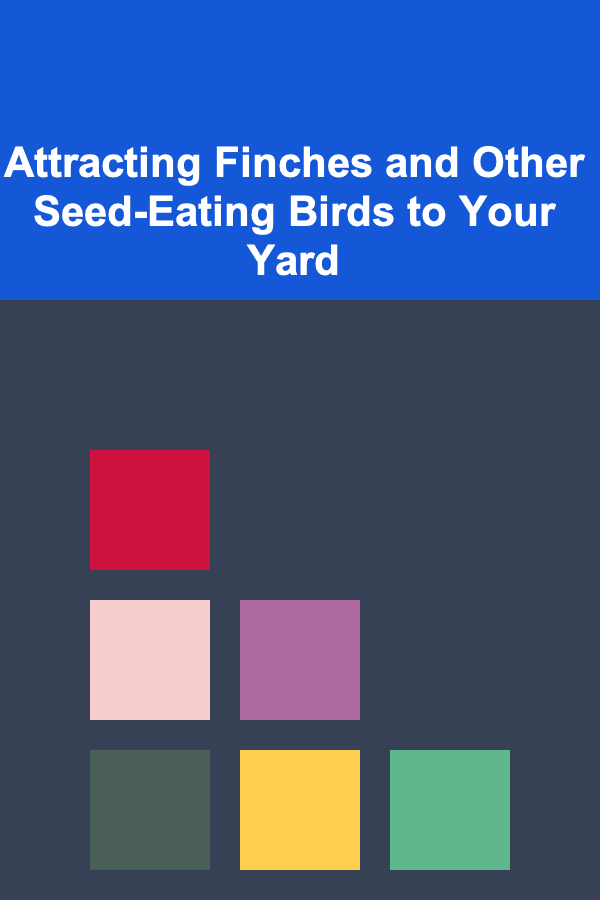
Attracting Finches and Other Seed-Eating Birds to Your Yard
ebook include PDF & Audio bundle (Micro Guide)
$12.99$8.99
Limited Time Offer! Order within the next:

Creating a bird-friendly habitat in your yard is a rewarding endeavor, bringing the beauty and vibrancy of nature right to your doorstep. Among the most charming and sought-after visitors are finches and other seed-eating birds. These delightful creatures add color, song, and a touch of wildness to any garden. This article delves into the comprehensive strategies you can employ to attract these feathered friends, transforming your yard into a haven for seed-loving birds.
Understanding Finch and Seed-Eating Bird Behavior
Before diving into specific attraction methods, it's crucial to understand the fundamental needs and preferences of finches and other seed-eating birds. This knowledge will inform your choices and ensure that your efforts are effective.
Dietary Needs
The primary appeal for seed-eating birds is, naturally, seeds. However, their dietary requirements are more nuanced than simply providing any type of seed. Different species have preferences for specific seed types, sizes, and even the way they are presented.
- Finches: Finches are particularly fond of small seeds, especially Nyjer (thistle) seeds and sunflower seeds. Their beaks are specifically adapted for cracking open these types of seeds. Goldfinches, House Finches, Purple Finches, and Pine Siskins are common finch visitors to backyard feeders.
- Sparrows: Sparrows, such as White-throated Sparrows, Song Sparrows, and American Tree Sparrows, also consume seeds but may prefer larger varieties like millet, cracked corn, and sunflower seeds. They often forage on the ground for dropped seeds.
- Juncos and Towhees: These ground-feeding birds are attracted to millet, sunflower seeds, and even weed seeds. They prefer to scratch and forage among leaf litter and under bushes.
- Doves and Pigeons: While often overlooked in discussions of desirable backyard birds, doves and pigeons are also seed-eaters. They readily consume larger seeds like corn and millet, and often feed on the ground.
Beyond seeds, these birds may also supplement their diet with insects (especially during breeding season), berries, and even nectar in some cases. Offering a variety of food sources will attract a greater diversity of bird species.
Habitat Requirements
Food is only one component of a bird-friendly habitat. Birds also need shelter, nesting sites, and water. Providing these elements will significantly increase the likelihood of attracting and retaining finches and other seed-eating birds in your yard.
- Shelter: Birds need shelter from predators, harsh weather, and other disturbances. Trees, shrubs, and dense vegetation provide essential cover. Evergreen trees and shrubs are particularly valuable during the winter months.
- Nesting Sites: Different species have different nesting preferences. Some prefer cavities in trees, while others build nests in shrubs or on the ground. Providing a variety of nesting options will attract a wider range of birds. Consider installing birdhouses specifically designed for finches or sparrows.
- Water: Access to fresh, clean water is crucial for birds, both for drinking and bathing. A bird bath, pond, or even a shallow dish of water can be a significant draw. Keep the water clean and ice-free during the winter months.
Behavioral Patterns
Understanding bird behavior can also help you optimize your efforts. For example, knowing that some birds are ground feeders while others prefer to feed from elevated perches will influence the type of feeders you choose and where you place them. Furthermore, recognizing that birds are more active at certain times of the day (e.g., early morning and late afternoon) will help you time your feeding efforts accordingly.
Choosing the Right Feeders and Seeds
Selecting the appropriate feeders and seeds is paramount to attracting finches and other seed-eating birds. The right combination will cater to their specific needs and preferences, ensuring a constant flow of visitors to your yard.
Types of Feeders
The market offers a wide array of bird feeders, each designed for different types of birds and seeds. Here are some of the most effective feeder types for attracting finches and other seed-eating birds:
- Nyjer (Thistle) Feeders: These specialized feeders have small openings designed specifically for Nyjer seeds. They prevent other birds from easily accessing the seeds, making them ideal for attracting finches. Look for feeders made of durable materials with easy-to-clean components.
- Tube Feeders: Tube feeders with multiple perches are versatile and can accommodate a variety of seeds, including sunflower seeds, millet, and mixed birdseed. Choose feeders with metal ports to prevent squirrels from damaging them.
- Hopper Feeders: Hopper feeders hold a large quantity of seeds and are a good option for attracting a variety of birds, including sparrows and finches. Look for feeders with a roof to protect the seeds from rain and snow.
- Platform Feeders: Platform feeders, also known as tray feeders, are simple and attract a wide range of birds, including ground feeders. They are ideal for offering larger seeds like sunflower seeds and cracked corn. However, they are more susceptible to squirrels and weather exposure.
- Ground Feeders: Ground feeders are simply trays or shallow dishes placed on the ground. They are perfect for attracting ground-feeding birds like juncos, towhees, and sparrows. Keep them clean and free from debris.
Selecting the Right Seeds
As mentioned earlier, different birds have different seed preferences. Offering a variety of seeds will attract a greater diversity of species.
- Nyjer (Thistle) Seeds: Nyjer seeds are a favorite of finches, especially Goldfinches. They are small, black, and rich in oil.
- Sunflower Seeds: Sunflower seeds are a staple for many seed-eating birds. Black oil sunflower seeds are particularly nutritious and have a high oil content. They are also easier for birds to crack open.
- Hulled Sunflower Seeds (Sunflower Hearts): Hulled sunflower seeds are already shelled, making them even easier for birds to eat. They also eliminate the mess of discarded shells.
- Millet: Millet is a small, round seed that is a favorite of sparrows, juncos, and other ground-feeding birds. White proso millet is the most commonly used variety.
- Cracked Corn: Cracked corn is a good source of energy for birds, especially during the winter months. It is particularly attractive to doves, pigeons, and sparrows.
- Mixed Birdseed: Many commercially available birdseed mixes contain a variety of seeds, including sunflower seeds, millet, cracked corn, and other grains. Choose a mix that is high in sunflower seeds and millet and low in filler seeds like red millet and wheat.
Seed Presentation
How you present the seeds can also influence which birds you attract. For example, offering sunflower seeds in a tube feeder with small perches will primarily attract finches, while scattering millet on the ground will appeal to sparrows and juncos. Experiment with different presentation methods to see what works best in your yard.
Creating a Bird-Friendly Landscape
While feeders provide a readily available food source, creating a bird-friendly landscape will provide a more sustainable and natural habitat for finches and other seed-eating birds. This involves incorporating plants that provide food, shelter, and nesting sites.
Planting Native Species
Native plants are best adapted to your local climate and soil conditions, and they provide the most nutritious and beneficial food sources for native birds. Choose plants that produce seeds, berries, and nuts that birds will enjoy.
- Seed-Producing Plants: Coneflowers, sunflowers, asters, and goldenrods are excellent choices for attracting seed-eating birds. Leave the seed heads on the plants throughout the winter to provide a natural food source.
- Berry-Producing Shrubs: Serviceberries, dogwoods, viburnums, and elderberries provide berries that birds love.
- Trees: Oak trees produce acorns that are eaten by a variety of birds and mammals. Evergreen trees provide shelter and nesting sites.
Providing Shelter and Nesting Sites
As mentioned earlier, shelter and nesting sites are essential for attracting and retaining birds in your yard. Incorporate a variety of trees, shrubs, and ground cover to provide these resources.
- Evergreen Trees and Shrubs: Provide year-round shelter and protection from the elements.
- Deciduous Trees and Shrubs: Offer shade and nesting sites during the warmer months.
- Dense Vegetation: Provides cover from predators and nesting sites for ground-nesting birds.
- Birdhouses: Install birdhouses specifically designed for finches or sparrows. Place them in sheltered locations, away from predators.
Water Features
Water is a critical resource for birds, especially during hot and dry weather. Providing a bird bath, pond, or other water feature will significantly enhance your bird-friendly habitat.
- Bird Baths: Choose a bird bath with a shallow basin and a rough surface to provide good footing. Clean the bird bath regularly to prevent the spread of disease.
- Ponds: A pond can provide a source of water for birds and other wildlife. Incorporate shallow areas and rocks for birds to perch on.
- Dripping Water: Birds are attracted to the sound of dripping water. Consider installing a dripping fountain or a hose with a slow drip.
Maintaining a Natural Yard
Avoid using pesticides and herbicides, as these chemicals can harm birds and other wildlife. Instead, embrace natural gardening practices, such as composting, mulching, and hand-weeding. Leave leaf litter in the fall to provide habitat for insects and other invertebrates that birds eat.
Managing Predators and Other Challenges
Attracting birds to your yard also means attracting predators, such as cats, hawks, and squirrels. It's important to take steps to minimize the risk to the birds while still enjoying their presence.
Protecting Birds from Cats
Cats are a major threat to birds. Keep your cats indoors, especially during the spring and summer months when birds are nesting and raising young. If you allow your cats outdoors, provide them with a bell or other deterrent to warn birds of their presence.
Discouraging Squirrels
Squirrels can be a nuisance at bird feeders, often monopolizing the food and preventing birds from accessing it. There are several strategies you can use to deter squirrels:
- Squirrel-Proof Feeders: These feeders are designed to prevent squirrels from accessing the seeds. They may have cages or baffles that keep squirrels away.
- Placement of Feeders: Place feeders away from trees, fences, and other structures that squirrels can use to jump onto the feeders.
- Offering Squirrel Food: Provide squirrels with their own food source, such as corn or nuts, in a separate location away from the bird feeders.
- Baffles: Install baffles above and below feeders to prevent squirrels from climbing onto them.
Preventing Disease
Bird feeders can become breeding grounds for bacteria and fungi that can cause disease. Clean your feeders regularly, at least once a week, with a solution of one part bleach to nine parts water. Rinse the feeders thoroughly and allow them to dry completely before refilling them.
Dealing with Unwanted Birds
While you may want to attract a variety of birds, some species, such as starlings and house sparrows, can be aggressive and outcompete native birds for food and nesting sites. If these birds become a problem, you can try removing their nests or using feeders that are specifically designed to exclude them.
Maintaining Your Bird-Friendly Habitat
Creating a bird-friendly habitat is an ongoing process. Regular maintenance is essential to ensure that your yard remains attractive and safe for birds.
Regular Cleaning and Maintenance
- Clean Feeders Regularly: As mentioned earlier, clean your feeders at least once a week to prevent the spread of disease.
- Clean Bird Baths Regularly: Clean bird baths regularly to remove algae and debris.
- Prune Trees and Shrubs: Prune trees and shrubs to maintain their shape and health. Remove dead or diseased branches.
- Maintain Water Features: Keep ponds and other water features clean and free from debris.
- Replenish Seed Supply: Keep your feeders filled with fresh seed.
Observing and Adjusting
Pay attention to which birds are visiting your yard and what they are eating. Adjust your feeding and landscaping strategies based on your observations. Experiment with different types of feeders, seeds, and plants to see what works best in your area.
Seasonal Considerations
Birds' needs change throughout the year. During the winter months, birds need high-energy foods to survive the cold weather. During the spring and summer months, they need protein-rich foods to feed their young. Adjust your feeding and landscaping strategies accordingly.
Conclusion
Attracting finches and other seed-eating birds to your yard is a rewarding experience that can bring joy and beauty to your life. By understanding their needs and preferences, providing the right food and habitat, and managing potential challenges, you can transform your yard into a haven for these delightful creatures. Remember to be patient and persistent, and enjoy the process of creating a bird-friendly oasis.
By implementing the strategies outlined in this article, you'll not only attract a vibrant array of finches and other seed-eating birds, but you'll also contribute to the conservation of these important species. Your yard will become a valuable resource for birds, providing them with the food, shelter, and water they need to thrive.

How to Handle Lease Renewals with Tenants
Read More
The Catering Manager's Toolkit: From Concept to Service in Catering Operations
Read More
Top Tips for Choosing Cost-Effective Gym Memberships That Fit Your Budget
Read More
How to Develop Blockchain Oracles
Read More
Mastering a Strong Online Presence for Print-on-Demand (POD)
Read More
10 Tips for Healthcare Administrator Career Advancement
Read MoreOther Products

How to Handle Lease Renewals with Tenants
Read More
The Catering Manager's Toolkit: From Concept to Service in Catering Operations
Read More
Top Tips for Choosing Cost-Effective Gym Memberships That Fit Your Budget
Read More
How to Develop Blockchain Oracles
Read More
Mastering a Strong Online Presence for Print-on-Demand (POD)
Read More